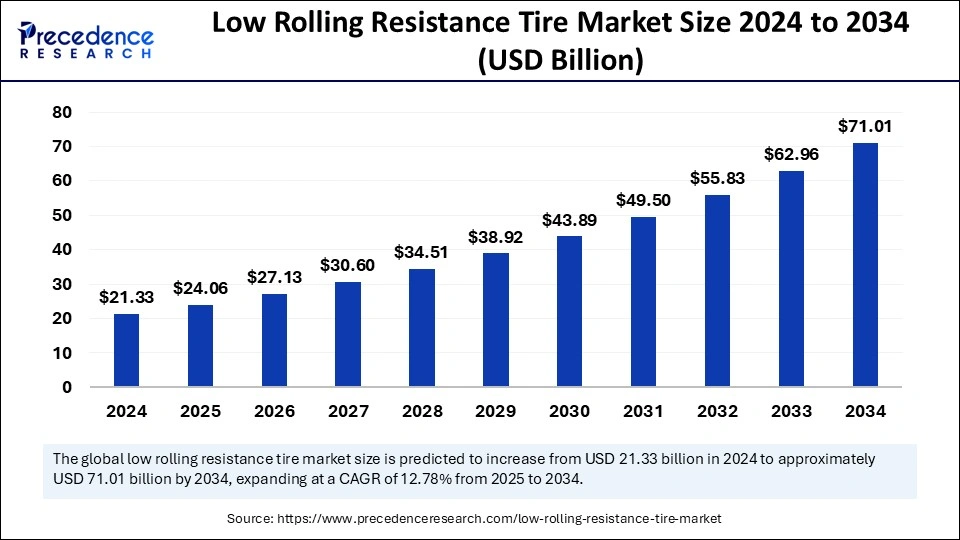
Low Rolling Resistance Tire Market Key Takeaways
- North America led the low rolling resistance tire market with the largest market share of 36% in 2024.
- Asia Pacific is expected to grow at a notable CAGR of 13.9% in the coming years.
- By vehicle, the passenger cars segment held the major market share of 42% in 2024.
- By vehicle, the electric vehicles segment is projected to grow at the fastest rate during the forecast period.
- By width, the wide band segment dominated the market in 2024.
- By width, the dual width segment is anticipated to grow at a steady growth rate over the studied period.
- By sales channel, the OEMs segment contributed the biggest market share of 61% in 2024.
- By sales channel, the aftermarket segment is expected to expand at a rapid pace in the upcoming period.
Low Rolling Resistance Tire Market Overview
The Low Rolling Resistance (LRR) Tire Market is gaining significant momentum due to the increasing emphasis on fuel efficiency and sustainable transportation. These tires are designed to reduce the energy loss as a tire rolls, thereby improving vehicle efficiency and reducing carbon emissions. Automotive manufacturers and consumers alike are recognizing the value of LRR tires as an effective way to meet environmental standards and lower operational costs.
Low Rolling Resistance Tire Market Drivers
One of the main drivers for the growth of the low rolling resistance tire market is the global push toward reducing greenhouse gas emissions. Regulatory bodies in various regions are implementing stringent fuel efficiency norms, compelling automakers to integrate energy-efficient components. The rising prices of fossil fuels have also led to a surge in demand for technologies that can enhance fuel economy, making LRR tires a preferred choice.
Opportunities
The market presents promising opportunities as electric vehicle adoption increases worldwide. Since LRR tires enhance battery performance and range by minimizing energy loss, they are well-suited for EVs. Additionally, the growing consumer awareness about environmental impact and operational savings is encouraging tire manufacturers to innovate and expand their LRR tire product lines.
Challenges
Despite their benefits, low rolling resistance tires face challenges such as higher initial costs and limitations in performance under certain road conditions. Consumers may also perceive them as less durable or less grippy compared to traditional tires, especially in extreme weather. Furthermore, balancing performance, durability, and cost remains a critical concern for manufacturers.
Regional Insights
Asia-Pacific leads the global low rolling resistance tire market, supported by the rapid expansion of the automotive sector and increasing environmental regulations in countries like China, Japan, and India. North America and Europe follow closely due to strong consumer demand for fuel-efficient vehicles and the presence of leading tire manufacturers. Latin America and the Middle East are gradually entering the market, driven by rising automotive sales and growing awareness of sustainability.
Recent Developments
In recent years, tire manufacturers have invested heavily in R&D to improve the performance of LRR tires. New compounds, advanced tread designs, and eco-friendly materials are being introduced to enhance rolling efficiency without compromising safety. Several companies are forming strategic partnerships with automakers to supply LRR tires for upcoming electric and hybrid vehicle models, further driving market adoption.
Low Rolling Resistance Tire Market Companies
- Bridgestone Corporation
- Michelin
- Goodyear Tire & Rubber Company
- Continental AG
- Pirelli & C. S.p.A.
- Hankook Tire
- Yokohama Rubber Co. Ltd.
- Apollo Tyres Ltd.
- Cheng Shin Rubber Industry Co. (Maxxis)
- Kumho Tire
- Zhongce Rubber Group Co., Ltd. (ZC-Rubber)
- Nokian Tyres plc
- MRF Tyres
- Sumitomo Rubber Industries, Ltd.
- Firestone Tire and Rubber Company
- Cooper Tire & Rubber Company
- Toyo Tire & Rubber Company
Segments Covered in the Report
By Vehicle
- Passenger Vehicles
- Light Commercial Vehicles
- Heavy Commercial Vehicles
- Electric Vehicles
By Width
- Dual Width
- Wide Band
By Sales Channel
- OEM
- Aftermarket
By Regional
- North America
- Europe
- Asia Pacific
- Latin America
- Middle East & Africa